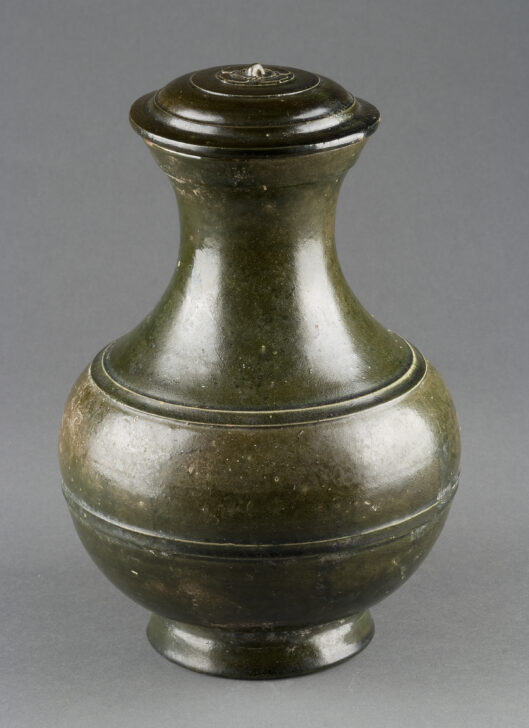Covered Jar
Chinese

Description
High-fired glazed earthenware emerged in China in the late Zhou dynasty around 500 BCE to 400 BCE and were modeled on more elite and expensive vessels made in bronze. The shape of these two jars is based on a popular bronze wine container of an earlier period known as hu in Chinese. The shape is elegant, with flaring dish-like mouth, tall narrow neck, wide sloping shoulder, and a swelling bulbous body tapering to a solid base. The applied pierced knob on top of the covered hu and taotie “animal mask” handles with non-functional rings on the coverless hu (1993/1.83) were borrowed directly from bronze art, as were the double and triple “bowstrings” that circle the body and mouth area of the vessels. The metallic-looking green glazes of these jars, further strengthening the resemblance to bronze, resulted from using lead silicate with the addition of copper oxide as the colorant. Both vessels are believed to be mortuary objects.
(Label for UMMA Chinese Gallery Opening Rotation, March 2009)
Subject Matter:
An earthenware hu (壺) jar for storing millet ale, sometimes referred to as "wine". The shape and green glaze mimicks bronze forms. These types of jars were made in abundance as funerary storage vessels to supply for the afterlife and have been found in the tombs of Han citizens in both middle and elite social classes.
Physical Description:
A red earthenware, tall jar with a globular body, a curved trumpet flaring neck, an everted rim with articulation, and a tall flared foot ring. There are appliqué bands around the body, a dome cap lid with a flared articulated rim, band detailing, and a loop central finial. It is covered in a dark olive green lead glaze.
Usage Rights:
If you are interested in using an image for a publication, please visit https://umma.umich.edu/request-image/ for more information and to fill out the online Image Rights and Reproductions Request Form.